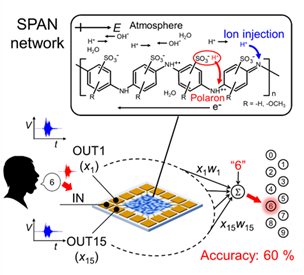
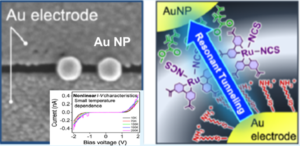
Using nanolithography and self-assembling methods, we are investigating electrical conduction of single and/or small number of molecules that are constituents of neuromorphic molecular networks. Generally, single molecular electrical conduction exhibits complicated behavior with considerable zero-bias conductance due to strong coupling between molecular orbitals and electronic stats of metal electrodes. We propose that resonant tunneling through molecular orbitals with isolation layers are useful to obtain sharp threshold and strong nonlinearity in current-voltage characteristics. We realized resonant tunneling with sharp threshold and without hopping conduction and temperature dependence using nanoparticle bridge junction. This steep nonlinearity is essential to neuromorphic molecular electronics. Furthermore, we focus mixed valence states of molecules providing memory functions and the projects on this direction is now running.

Nanoscale observation of charge distribution and electric polarization is crucial for understanding and controlling functional materials and devices. In particular, the importance of charge dynamics is well recognized, and direct methods to observe charge generation, transfer, and recombination processes are required. We developed tip-synchronized time-resolved electrostatic force microscopy. The tip-synchronized method increases the range of time-resolved electrostatic force microscopy, paving the way for studies of nanoscale charge dynamics. This method enables us to resolve sub-microsecond charge generation, migration and migration on the surface. Charge dynamics of photovoltaic thin films, hot carrier generation and charge separation with plasmon excitation of metal nanoparticles, and charge propagation in network-based molecular devices are currently investigated.

In the field of life science, the imaging technique using the fluorescence labeling method has been remarkably progressed in recently. However, “non-radiative fluorescence” interactions also play the key role in the transportation and the signal transmission of molecules with the protein. These functions of protein can be clarified by the measurements of electrostatic force, which is the driving force of transportations. We measure the dynamical measurements for example molecular interaction, charge distribution and elastic force by the frequency shift. Our study is aimed to the elucidation for the function of proteins in chemical reaction theory and physical chemistry.
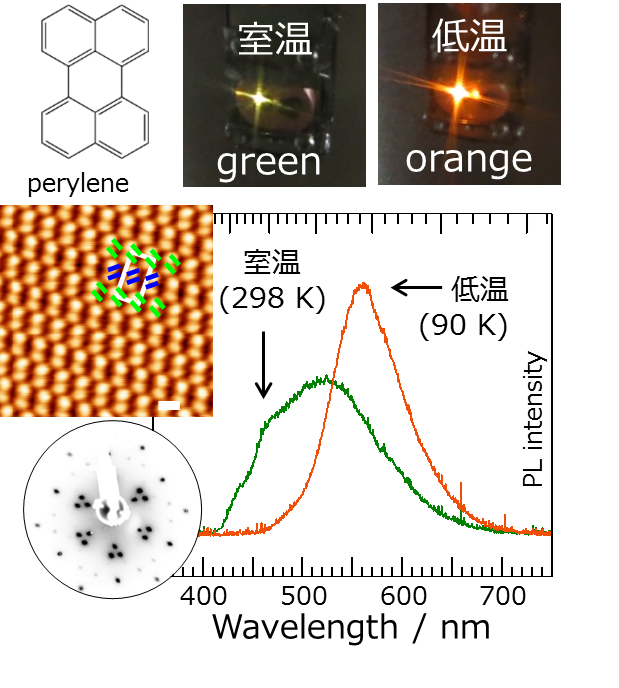
In recent decades, organic semiconductors are widely utilized for optoelectronic device such as electronic luminescence(OEL), solar cell, sensors, etc. Here, we focus on the organic/electrode interface, because excited charges are significantly influenced by the substrate acting as a thermalized electron bath. Mainly, two-factors listed below, 1) Energy level alignment at the molecule/substrate interface 2) Femtosecond dynamics of the excited charges generated at the interface, these two can be a key to improve the device performance. By utilizing surface-science based-techniques, scanning tunneling microscopy/spectroscopy (STM/STS), low-energy electron diffraction (LEED), and two-photon photoemission spectroscopy (2PPE), we’re challenging to elucidate the correlation between electronic, geometric and photoluminescent properties at the organic/substrate interfaces.
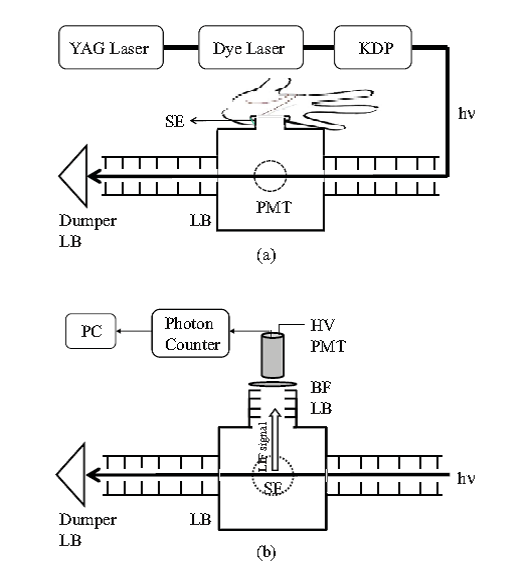
It is well known that the more than 1800 kinds of molecules are emanated from human body. (expiration, skin etc.) But these gases are low molecular weight with molecular weight less than 100. Emanated gas molecules from human body are metabolism product formed by the living body or intestinal bacteria, there is much metabolism information in the living body related to the condition of a patient and an oxidation stress disease and includes it. Our study is aimed to the development of the new gas analysis system with high detection efficiency using the laser spectroscopy, leading to the patient diagnostic method.
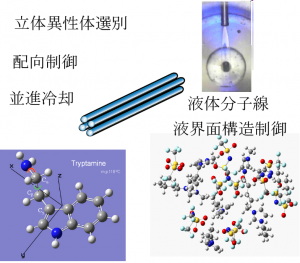
In general, the dominant freedoms controlling reaction are expected to shift from dynamical factors to interaction ones as the collision energy decreases. In order to elucidate the relationship between statistical factor and mode selectivity in the various processes on relaxation and on reaction, we are developing new techniques on the translational cooling and on the selection of geometric isomers for radical and biomolecules. Studies on stereodynamics at the gas-liquid interface is now in progress by using an ionic liquid beam with a translationally cooled and state-selected radical (biomolecule) beam.